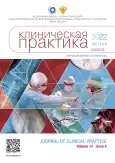The role of magnetic resonance imaging in the early diagnosis of chronic lymphocytic inflammation (CLIPPERS syndrome)
- Authors: Fomina L.E.1, Kieva I.N.2, Anikin A.V.1, Nudnov N.V.3, Abdullaeva L.M.1
-
Affiliations:
- National Medical Research Center for Children's Health
- G.N. Speransky Children's City Clinical Hospital № 9
- Russian Scientific Center of Roentgenoradiology
- Issue: Vol 13, No 4 (2022)
- Pages: 109-119
- Section: Case reports
- URL: https://journals.rcsi.science/clinpractice/article/view/144176
- DOI: https://doi.org/10.17816/clinpract114814
- ID: 144176
Cite item
Full Text
Abstract
Background: Chronic lymphocytic inflammation with perivascular contrast enhancement in the pons responsive to steroids (CLIPPERS) is a rare and relatively new pathology and magnetic resonance imaging (MRI) is highly important in its diagnosis.
Clinical case description: The analysis of the MRI results revealed typical changes characteristic of CLIPPERS, such as contrast-positive small-point and curvilinear lesions of the pons, medulla oblongata and midbrain, as well as of the cerebral peduncles and cerebellum. In addition to the changes we described, according to the literature, lesions of the white matter of the large hemispheres and thalami may also be observed in the syndrome of chronic lymphocytic inflammation.
Conclusion: MRI not only enables one to achieve high-quality neuroimaging of CLIPPERS, but also allows avoiding invasive, traumatic diagnostic methods.
Full Text
##article.viewOnOriginalSite##About the authors
Lyubov E. Fomina
National Medical Research Center for Children's Health
Author for correspondence.
Email: love.fomina@mail.ru
ORCID iD: 0000-0002-3838-3284
SPIN-code: 1298-8350
researcher, laboratory of radiation and instrumental diagnostics
Russian Federation, 2 b. 1, Lomonosovsky prospect, Moscow, 119991Irina N. Kieva
G.N. Speransky Children's City Clinical Hospital № 9
Email: miamodiaz@gmail.com
ORCID iD: 0000-0002-4060-5966
SPIN-code: 2279-9141
radiologist
Russian Federation, MoscowAnatoly V. Anikin
National Medical Research Center for Children's Health
Email: anikacor@gmail.com
ORCID iD: 0000-0003-0362-6511
SPIN-code: 7592-1352
MD, PhD
Russian Federation, MoscowNikolay V. Nudnov
Russian Scientific Center of Roentgenoradiology
Email: nudnov@rncrr.ru
ORCID iD: 0000-0001-5994-0468
SPIN-code: 3018-2527
MD, PhD
Russian Federation, MoscowLuizat M. Abdullaeva
National Medical Research Center for Children's Health
Email: instorm@inbox.ru
ORCID iD: 0000-0003-1574-2050
neurologist
Russian Federation, MoscowReferences
- Pittock SJ, Debruyne J, Krecke KN, et al. Chronic lymphocytic inflammation with pontine perivascular enhancement responsive to steroids (CLIPPERS). Brain. 2010;133(9):2626–2634. doi: 10.1093/brain/awq164
- Simon NG, Parrat JD, Barnett MH, et al. Expanding the clinical, radiological and neuropathological phenotype of chronic lymphocytic inflammation with pontine perivascular enhancement responsive to steroids (CLIPPERS). J Neurol Neurosurg Psychiatry. 2012;83(1):15–22. doi: 10.1136/jnnp-2011-301054
- Nemani T, Udwadia-Hegde A, Keni Karnavat P, et al. CLIPPERS spectrum disorder: A rare pediatric neuroinflammatory condition. Child Neurol Open. 2019;(6):2329048X19831096. doi: 10.1177/2329048X19831096
- Dudesek A, Rimmele F, Tesar S, et al. CLIPPERS: chronic lymphocytic inflammation with pontine perivascular enhancement responsive to steroids. Review of an increasingly recognized entity within the spectrum of inflammatory central nervous system disorders. Clin Exp Immunol. 2014;175(3): 385–396. doi: 10.1111/cei.12204
- Rauschenbach L, Kebir S, Radbruch A, et al. Challenging implications of chronic lymphocytic inflammation with pontine perivascular enhancement responsive to steroids syndrome with an atypical presentation: Report of two cases. World Neurosurg. 2020;(143):507–512.e1. doi: 10.1016/j.wneu.2020.07.123
- Kamişli Ö, Tecellioğlu M, Erbay MF, et al. Two new cases and literature review of clippers syndrome with long-term follow-up. Noro Psikiyatr Ars. 2020;57(2):160–164. doi: 10.5152/npa.2017.22732
- Kerrn-Jespersen BM, Lindelof M, Illes Z, et al. CLIPPERS among patients diagnosed with non-specific CNS neuroinflammatory diseases. J Neurol Sci. 2014;343(1-2):224–227. doi: 10.1016/j.jns.2014.06.002
- Tobin WO, Guo Y, Krecke KN, et al. Diagnostic criteria for chronic lymphocytic inflammation with pontine perivascular enhancement responsive to steroids (CLIPPERS). Brain. 2017; 140(9):2415–2425. doi: 10.1093/brain/awx200
- Сиверцева С.А., Сиверцев М.Ю., Бажухин Д.В., и др. Синдром CLIPPERS (обзор литературы и собственное наблюдение) // Журнал неврологии и психиатрии им. C.C. Корсакова. 2017. Т. 117, № 10-2. С. 24-34. [Sivertseva SA, Sivertsev MY, Bazhukhin DV, et al. CLIPPERS syndrome (literature review and own observation). J Neurology Psychiatry named after C.C. Korsakov. 2017;117(10-2):24–34. (In Russ).] doi: 10.17116/jnevro201711710224-34
- Buttmann M, Metz I, Brecht I, et al. Atypical chronic lymphocytic inflammation with pontocerebellar perivascular enhancement responsive to steroids (CLIPPERS), primary angiitis of the CNS mimicking CLIPPERS or overlap syndrome? A case report. J Neurol Sci. 2013;324(1-2):183–186. doi: 10.1016/j.jns.2012.10.017
- Cordano C, López GY, Bollen AW, Nourbakhsh B. Occipital headache in chronic lymphocytic inflammation with pontine perivascular enhancement responsive to steroids (CLIPPERS). Headache. 2018;58(3):458–459. doi: 10.1111/head.13232
- Taieb G, Allou T, Labauge P. Therapeutic approaches in CLIPPERS. Curr Treat Options Neurol. 2017;19(5):17. doi: 10.1007/s11940-017-0455-4
- Taieb G, Duflos C, Renard D, et al. Long-term outcomes of CLIPPERS (chronic lymphocytic inflammation with pontine perivascular enhancement responsive to steroids) in a consecutive series of 12 patients. Arch Neurol. 2012;69(7):847–855. doi: 10.1001/archneurol.2012.122
- Picarelli H, Yamaki VN, Casal YR, et al. CLIPPERS with exclusive extra pontine involvement. Neurol Neuroimmunol Neuroinflamm. 2021;8(3):e989. doi: 10.1212/NXI.0000000000000989
- Ambia AR, Al Zahrani N, Almakadma AH, et al. Chronic lymphocytic inflammation with pontine perivascular enhancement responsive to steroids: an acute presentation. Cureus. 2022;14(1):e21382. doi: 10.7759/cureus.21382
- Dang YL, Kok HK, McKelvie PA, et al. Chronic lymphocytic infiltration with pontine perivascular enhancement responsive to steroids (CLIPPERS) and its association with Epstein-Barr Virus (EBV)-related lymphomatoid granulomatosis: A case report. BMC Neurol. 2021;21(1):80. doi: 10.1186/s12883-021-02110-1
Supplementary files













